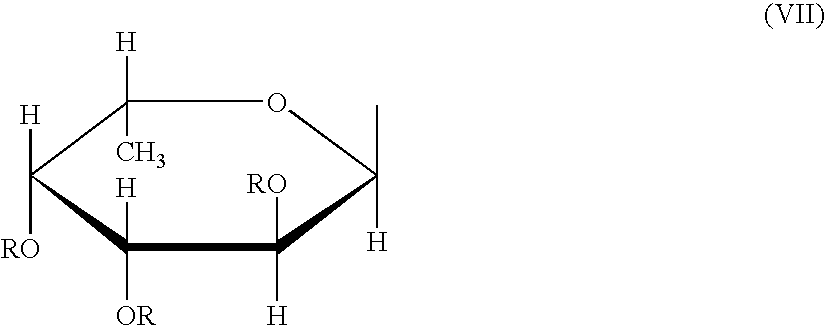Sulfated fucan
- Summary
- Abstract
- Description
- Claims
- Application Information
AI Technical Summary
Benefits of technology
Problems solved by technology
Method used
Image
Examples
referential example 1
Preparation of Sulfated Polysaccharide Fraction from Fucus vesiculosus
[0108] 1 kg of dried Fucus vesiculosus was disrupted and suspended in 10 L of 80% ethanol. The suspension was stirred at 25° C. for 3 hours, filtered and washed to obtain a residue. The residue was suspended in 30 L of 30 mM phosphate buffer (pH 6.5) containing 100 mM sodium chloride. The suspension was treated at 95° C. for 2 hours and then cooled to 30° C. 100 g of active carbon, 3000 U of alginate lyase K (Nagase Biochemicals) and 3.75 L of ethanol were added thereto. The mixture was stirred for 24 hours, and then centrifuged to obtain a supernatant. The supernatant was concentrated to 4 L using an ultrafiltration device equipped with hollow fibers with exclusion molecular weight of 100,000 and subjected to solvent exchange for 100 mM sodium chloride. The solution was cooled to 4° C., and the pH was adjusted to 2.0 with 0.5 N hydrochloric acid. The formed precipitate was removed by centrifugation to obtain a s...
referential example 2
Preparation of Sulfated Polysaccharide Fraction from Ascophyllum nodosum
[0109] 100 g of a sulfated polysaccharide fraction from Ascophyllum nodosum was obtained from 1 kg of commercially available Ascophyllum nodosum powder according to the method as described in Referential Example 1.
referential example 3
Preparation of Sulfated Polysaccharide Fraction from Kjellmaniella crassifolia
[0110] 38 g of a sulfated polysaccharide fraction from Kjellmaniella crassifolia was obtained according to the method as described in Referential Example 1 from 1 kg of chips prepared from commercially available dried Kjellmaniella crassifolia by disruption using a cutter mill (Masuko Sangyo).
PUM
| Property | Measurement | Unit |
|---|---|---|
| Temperature | aaaaa | aaaaa |
| Mass | aaaaa | aaaaa |
| Mass | aaaaa | aaaaa |
Abstract
Description
Claims
Application Information
 Login to View More
Login to View More - R&D
- Intellectual Property
- Life Sciences
- Materials
- Tech Scout
- Unparalleled Data Quality
- Higher Quality Content
- 60% Fewer Hallucinations
Browse by: Latest US Patents, China's latest patents, Technical Efficacy Thesaurus, Application Domain, Technology Topic, Popular Technical Reports.
© 2025 PatSnap. All rights reserved.Legal|Privacy policy|Modern Slavery Act Transparency Statement|Sitemap|About US| Contact US: help@patsnap.com



